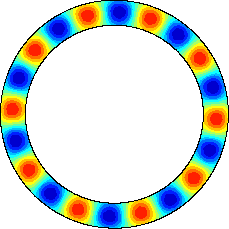
What is HotSpotter?THERMOELASTIC INSTABILITY (TEI) can occur in brakes and clutches as a result of an unstable interaction between frictional heating, thermoelastic distortion and elastic contact. It results in high local temperatures known as HOT SPOTS and these can cause low frequency noise and vibration known as HOT ROUGHNESS or HOT JUDDER in automotive brakes. High temperatures may also cause brake fade and excessive wear and this places operating limits on high performance aircraft brakes. Wet transmission clutch disks can exhibit discolored patches known as LEOPARD SPOTTING and the high thermal stresses developed can cause permanent deformation of the disk leading to CONING or POTATO CHIP deformation ("PRINGLING").
HOTSPOTTER is a finite element software package for evaluating the susceptibility of axisymmetric multidisk brakes and clutches to thermoelastic instability (TEI). An eigenvalue method is used to determine the exponential growth rate of eigenmodes of the system for a given rotational speed. The critical speed is then determined by searching for the lowest speed at which at least one mode has a positive growth rate.
How can HotSpotter help you?
What are the input and output parameters of HotSpotter?HotSpotter can be used as an aid in the design of transmission clutches and disk brakes against thermoelastic instability, which is believed to be significant source of material failure in clutches and of low frequency vibrations in brakes. Transient analysis of the problem involves a very small time increment for numerical stability and convergence and is therefore extremely computer-intensive. The HotSpotter algorithm uses the eigenvalue method which removes time from the governing equation. It also uses Fourier decomposition, which reduces the required finite element discretization to the cross sectional plane. These techniques greatly reduce computational time and increase numerical accuracy.
Who should use HotSpotter?Input parameters include
Output results include
- geometric parameters
- material properties
- boundary conditions
- sliding speed and/or hot spot number
- critical speed vs. hot spot number
- exponential growth rate vs. sliding speed
- dominant mode shapes
Clutch/Brake Design Engineers in automotive/airplane industry;
Researchers in the field of contact mechanics.
How to obtain an evaluation copy of Hotspotter
Download a standalone version of Hotspotter from http://mysite.du.edu/~yyi2/tei.html. This is the latest version of Hotspotter and it does not require the installation of Matlab. However, it will consume 30~50M of your hard disk space.
HotSpotter Home | Background | Features | References | Demonstration | Download Demo | Purchasing Information

J.R.Barber
Arthur F. Thurnau Professor of Mechanical Engineering and Applied MechanicsE-mail: jbarber@umich.edu
URL: http://www-personal.umich.edu/~jbarber/
Address:
J.R.Barber,
Department of Mechanical Engineering
University of Michigan
2350 Hayward Street
Ann Arbor MI 48109-2125Office Phone: (734) 936-0406
FAX: (734) 647-3170
You are visitor number 
Copyright 2000 by the Regents of the University of Michigan